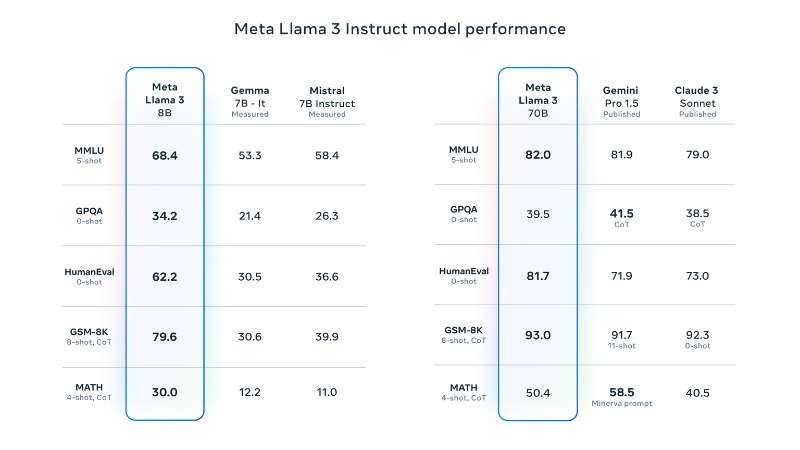- Launch of Llama 3: Meta released Llama 3 with versions having 8 billion and 70 billion parameters, and a 400 billion parameter model is in the works.
- Introduction of a New AI Chatbot: Meta launched a new stand-alone AI chatbot accessible at meta.ai, featuring image generation and competitive AI chat capabilities.
- Licensing and Accessibility: Despite being labeled as open source, Llama 3 is under a restrictive Meta-specific license, raising concerns about its accessibility and use in the open-source community.
Meta Platforms has launched Llama 3, their newest large language model (LLM), alongside a brand-new stand-alone AI chatbot. Llama 3 comprises two versions, one with 8 billion and the other with 70 billion parameters. Furthermore, Meta is currently developing an even more advanced 400 billion parameter model, though its release date remains unannounced.
Ragavan Srinivasan, Meta’s VP of Product, expressed enthusiasm about the model’s capabilities in a recent interview, stating, “From a performance perspective, it is really off the charts in terms of benchmarking capabilities.” He specifically referred to the ongoing development of the 400 billion parameter version.
The initial versions, Llama 3 8B and 70B, have demonstrated impressive performance, often surpassing or doubling the benchmarks of rival models from Google, Anthropic, and Mistral. Notably, the 8 billion parameter version excels in general knowledge and elementary math benchmarks, outperforming similar models like Gemma 7B and Mistral 7B Instruct.

Manohar Paluri, VP of AI at Meta, highlighted the superior performance of these models during a video conference interview. He noted, “What you see with this release, specifically Llama 3 8B and 70B, they are better than any other open model, and even comparable to some of the best closed models across all of these benchmarks.”
In terms of technical advancements, Llama 3 improves upon its predecessor with enhanced alignment, diversity in responses, and reduced error rates in tasks such as reasoning and code generation. The model’s training involved a blend of data, model, and pipeline parallelization, leading to a threefold increase in training efficiency.
Llama 3 has been trained on more than 15 trillion tokens, significantly more than Llama 2, and will be detailed further in an upcoming publication by Meta once the 400 billion parameter model is complete. The model’s extensive token context window also allows for more detailed and longer input prompts by users.
Alongside the launch of Llama 3, Meta introduced a new stand-alone AI chatbot, now accessible via www.meta.ai. This new offering positions itself as a competitor to established AI chatbots like OpenAI’s ChatGPT, Anthropic’s Claude 3, and HuggingFace’s HuggingChat. Meta’s CEO, Mark Zuckerberg, emphasized the intelligence of this new AI assistant in a video on Instagram, stating, “The bottom line is we believe Meta AI is the most intelligent AI assistant that you can freely use.”
The Meta AI chatbot features a dialogue box for interactions and is equipped with Meta Imagine, an image generation model based on a diffusion AI model previously known as Emu, trained on a vast dataset from Facebook and Instagram. This model stands out by allowing users to see image generation in real-time as they type.
Meta AI, similar to ChatGPT, pulls live information from the web using Microsoft’s Bing and can access Google search results, much like Google’s Search Generative Experience. However, it currently lacks multimodal capabilities, such as uploading images or documents, which are available in some other leading LLMs. Sources at Meta suggest that a multimodal version of Llama is in development and could be released soon.
Moreover, Llama 3 is part of Meta’s broader strategy to integrate AI across its various platforms, potentially reaching billions of users through integrated search functionalities in apps like WhatsApp, Instagram, Facebook, and Messenger.
Despite its classification as “open source,” Llama 3’s release under a Meta-specific license similar to that of Llama 2 has sparked debate within the open-source community. The license allows commercial use but restricts enterprises with over 700 million monthly users unless a separate agreement is obtained from Meta.
For those interested, Llama 3 is now available for download on Meta’s AI website and accessible through major cloud platforms such as Amazon Sagemaker, AWS, Databricks, Google Cloud, Hugging Face, Kaggle, IBM WatsonX, Microsoft Azure, NVIDIA NIM, and Snowflake.